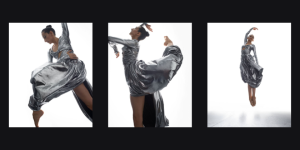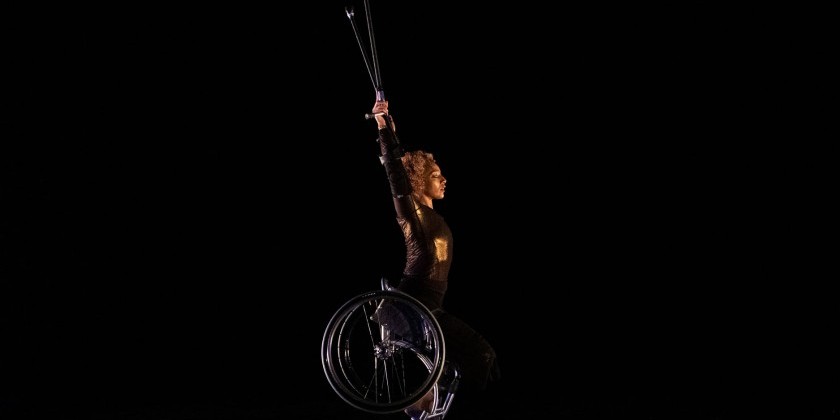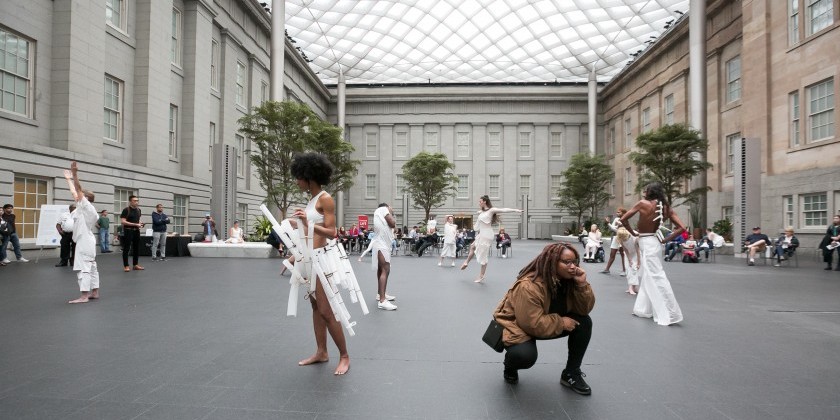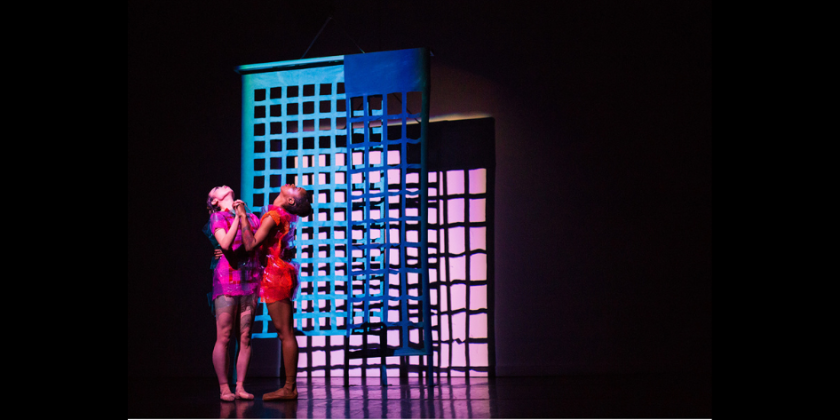IMPRESSIONS: “One + One Make Three,” a New Documentary-Dance Film as Part of ALL ARTS Past, Present, Future Festival
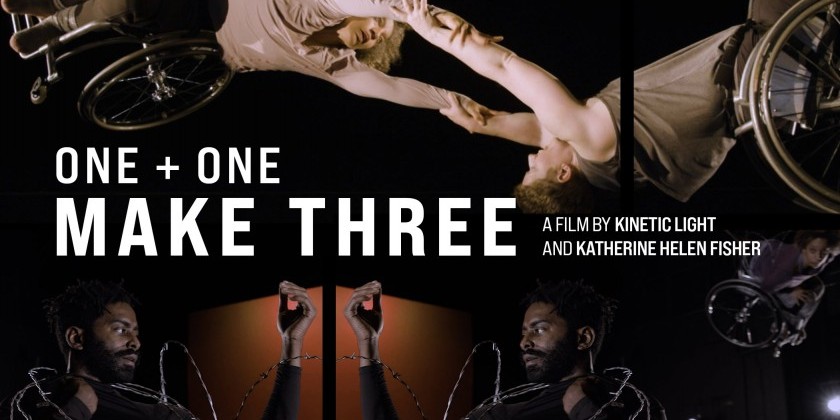
Cover image description: A combination of various images from the film One + One Make Three. At the top, Alice and Laurel outstretched in full horizontal flight: Alice, a multiracial Black woman with short curly hair and coffee-colored skin, and Laurel, a pale white woman with short-cropped brown hair, twist and connect in a black sky. Their hands link to each other’s wrists to form a human infinity loop in midair: Laurel on her back and Alice twisting sideways. Their wheelchairs glint in the light. Below them, text, in all-caps white lettering: “One + One Make Three a film by Kinetic Light and Katherine Helen Fisher.” Below the words is a mirrored image of Jerron, a dark-skinned Black man with a beard and twisted black hair. He is wrapped in barbed wire that encircles his upper body before trailing out of frame. In deep focus, he looks at his right hand as it emerges through the wire. Suspended high above and far-right, a blurry Alice is barely visible in the shadows; she arches toward Jerron in curiosity, forming a tight ball. The backdrop glows a deep orange rust color.
Film Director: Katherine Helen Fisher
Choreographer: Alice Sheppard
Choreographic Collaborators: Jerron Herman, Laurel Lawson
Performers: Jerron Herman, Laurel Lawson, and Alice Sheppard
Premiered May 11 on ALL ARTS (NYC for broadcast, available online globally)
What the pandemic-changed future looks like is a ripe topic for exploration in new art. The ALL ARTS Past, Present, Future festival invites choreographers to partner with filmmakers of their choice to produce works about what past, present, and future mean to them, personally and artistically. Kinetic Light — Alice Sheppard’s project-based ensemble that works at the intersections of disability, dance, design, identity, and technology — joined forces with director Katherine Helen Fisher to produce One + One Make Three, which takes us behind the scenes to the creation of Wired, an aerial dance work and collaboration among dancers Jerron Herman, Laurel Lawson, and Sheppard. Brilliant and multi-layered, One + One Make Three examines the experience of making live art in 2020 and what it means to be a disabled artist while offering insight into the creation of a multidisciplinary conceptual work.
One + One Make Three presents footage of Herman, Lawson, and Sheppard in a massive warehouse rehearsing Wired. Sunshine from through floor-to-ceiling windows illuminates the dancers, who are oftentimes in wheelchairs and suspended from the ceiling by large cables wrapped around their torsos.
Not limited by gravity, they access the breadth and depth of this tremendous space by experimenting with locomotion: crawling, rolling, bouncing, and flying. In one instance, two dancers in wheelchairs float parallel to the ground, the footplates facing outward, forming an infinity loop through their interlocked arms. The camera angle offers a variety of perspectives to display the performers’ three-dimensional bodies in ways that could not be captured on a proscenium stage.

Sometimes silver barbed wire wraps around the dancers’ bodies. Standing out against a black backdrop, it invokes a sense of danger — how do they keep from stabbing themselves? In a memorable image, Herman, swathed in wire, holds up Sheppard, who hangs from the ceiling, wheels in the air.
The stunning visuals are overlaid with interviews from the dancers that spark challenging conversations about how to speak about disability and access. Does the disabled body inherently have something different to say, and could we consider disability part of its own culture and aesthetic? How can disability enable new understandings of the moving world?
One + One Make Three considers the theme of accessibility versus inaccessibility. Sheppard developed Wired in response to Melvin Edwards’ “Pyramid Up and Down Pyramid,” from 1969 and refabricated in 2017 for The Whitney. She was fascinated by the barbed wire and its intended purpose — to divide land, hence dividing humans to forge a distinction between “us” and “them.” The film asks us how we might embrace and celebrate differences while providing equal access to opportunities.
Accessibility also comes up in the film’s presentation, which can be experienced via two streams of ASL interpretation, multi-voiced enhanced audio description, and integrated open captions. To reach the widest range of audiences, art must be accessible, and Kinetic Light views these offerings, which were created in collaboration with other disabled artists and community members, as integral to the art itself. The company’s advocacy for accessibility inspired ALL ARTS to make the entire festival and the marketing efforts accessible.

Sheppard speaks about each dancer’s unique offerings in the inherently collaborative Wired. The choreography itself involves lots of partnering and mutual support that demands a high level of trust among the cast. The title One + One Makes Three derives from the idea that a duo can manifest something greater than the sum of its parts.
Another compelling idea is the conversation around vulnerability. Lawson says, “All dance … requires the ability on the part of the choreographer to cultivate and elicit vulnerability in the piece and the ability on the part of the performers to offer and portray it.” Perhaps a disabled dancer has a unique relationship with vulnerability, especially in a world that often tells us vulnerability is weakness.
One + One Make Three begins and ends with the dancers in nature. During the opening, they are in a tree, mimicking the tree’s limbs with graceful extensions of their arms and legs. At the conclusion, they kneel in the sand on the beach, their bodies reflecting the shapes of rocks in the background.
The film is divided into two parts: present and future. These delineations speak to the creation of the piece and to the ongoing dialogue around disabled art. As we emerge from the fog of the last year and look toward the future, expanding expression through movement feels crucial to our emotional recovery.
In addition to Kinetic Light’s One + One Make Three, the ALL ART’s Past, Present, Future festival also includes A.I.M by Kyle Abraham’s If We Were a Love Song, directed by Dehanza Rogers, and Pam Tanowitz Dance’s DANCERS (Slightly Out of Shape), directed by Liz Sargent.





